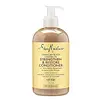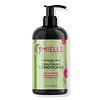What's inside
What's inside
 Key Ingredients
Key Ingredients

No key ingredients
 Benefits
Benefits

 Concerns
Concerns

 Ingredients Side-by-side
Ingredients Side-by-side

Water
Skin ConditioningStearyl Alcohol
EmollientButyrospermum Parkii Butter
Skin ConditioningCocos Nucifera Oil
MaskingCetyl Alcohol
EmollientParfum
MaskingBehentrimonium Chloride
PreservativeGlycerin
HumectantHydroxyethylcellulose
Emulsion StabilisingRicinus Communis Seed Oil
MaskingMacadamia Ternifolia Seed Oil
EmollientAcetic Acid
BufferingSimmondsia Chinensis Seed Oil
EmollientMauritia Flexuosa Fruit Oil
Skin ConditioningHydrolyzed Keratin
HumectantNiacin
SmoothingHydrolyzed Rice Protein
Skin ConditioningTocopherol
AntioxidantGlycine Soja Oil
EmollientHydrolyzed Wheat Protein
Skin ConditioningHydrolyzed Wheat Starch
Skin ConditioningMentha Piperita Leaf Extract
Skin ConditioningTrifolium Pratense Flower Extract
AstringentAloe Barbadensis Leaf Juice
Skin ConditioningPanthenol
Skin ConditioningCaramel
Cosmetic ColorantPropanediol
SolventYeast Extract
Skin ConditioningPolysorbate 60
EmulsifyingDisodium Phosphate
BufferingCaprylhydroxamic Acid
Caprylyl Glycol
EmollientBenzoic Acid
MaskingWater, Stearyl Alcohol, Butyrospermum Parkii Butter, Cocos Nucifera Oil, Cetyl Alcohol, Parfum, Behentrimonium Chloride, Glycerin, Hydroxyethylcellulose, Ricinus Communis Seed Oil, Macadamia Ternifolia Seed Oil, Acetic Acid, Simmondsia Chinensis Seed Oil, Mauritia Flexuosa Fruit Oil, Hydrolyzed Keratin, Niacin, Hydrolyzed Rice Protein, Tocopherol, Glycine Soja Oil, Hydrolyzed Wheat Protein, Hydrolyzed Wheat Starch, Mentha Piperita Leaf Extract, Trifolium Pratense Flower Extract, Aloe Barbadensis Leaf Juice, Panthenol, Caramel, Propanediol, Yeast Extract, Polysorbate 60, Disodium Phosphate, Caprylhydroxamic Acid, Caprylyl Glycol, Benzoic Acid
Water
Skin ConditioningCetearyl Alcohol
EmollientPolyquaternium-7
Caprylic/Capric Triglyceride
MaskingBehentrimonium Chloride
PreservativeC12-15 Alkyl Benzoate
AntimicrobialParfum
MaskingPersea Gratissima Oil
Skin ConditioningPPG-3 Myristyl Ether
EmollientBiotin
AntiseborrhoeicButyrospermum Parkii Butter
Skin ConditioningCocos Nucifera Oil
MaskingRosmarinus Officinalis Leaf Oil
MaskingMentha Piperita Oil
MaskingOlea Europaea Fruit Oil
MaskingPanthenol
Skin ConditioningBehentrimonium Methosulfate
Diheptyl Succinate
EmollientCapryloyl Glycerin/Sebacic Acid Copolymer
Skin ConditioningCetyl Alcohol
EmollientWater, Cetearyl Alcohol, Polyquaternium-7, Caprylic/Capric Triglyceride, Behentrimonium Chloride, C12-15 Alkyl Benzoate, Parfum, Persea Gratissima Oil, PPG-3 Myristyl Ether, Biotin, Butyrospermum Parkii Butter, Cocos Nucifera Oil, Rosmarinus Officinalis Leaf Oil, Mentha Piperita Oil, Olea Europaea Fruit Oil, Panthenol, Behentrimonium Methosulfate, Diheptyl Succinate, Capryloyl Glycerin/Sebacic Acid Copolymer, Cetyl Alcohol
Ingredients Explained
These ingredients are found in both products.
Ingredients higher up in an ingredient list are typically present in a larger amount.
This ingredient is a preservative and often used for it's anti-static properties. You'll most likely see this ingredient in hair conditioners.
It does not cause irritation or sensitization in leave-on products at 1-5%.
This ingredient is also known as shea butter. It is an effective skin hydrator and emollient.
Emollients help soothe and soften your skin. It does this by creating a protective film on your skin. This barrier helps trap moisture and keeps your skin hydrated. Emollients may be effective at treating dry or itchy skin.
Shea butter is rich in antioxidants. Antioxidants help fight free-radicals, or molecules that may harm the body. It is also full of fatty acids including stearic acid and linoleic acid. These acids help replenish the skin and keep skin moisturized.
While Shea Butter has an SPF rating of about 3-4, it is not a sunscreen replacement.
Shea butter may not be fungal acne safe. We recommend speaking with a professional if you have any concerns.
Learn more about Butyrospermum Parkii ButterCetyl Alcohol is a fatty alcohol. Fatty Alcohols are most often used as an emollient or to thicken a product.
Its main roles are:
Though it has "alcohol" in the name, it is not related to denatured alcohol or ethyl alcohol.
The FDA allows products labeled "alcohol-free" to have fatty alcohols.
Learn more about Cetyl AlcoholCocos Nucifera Oil is obtained from the kernels of the coconut fruit. In other words, this is coconut oil.
Coconut Oil is rich in fatty acids with lauric acid making up the majority of these. It also contains linoleic acid. Due to this high fatty acid content, coconut oil helps trap moisture and soften skin.
Despite being antibacterial, coconut oil may not be great for acne-prone skin. It is comedogenic and may clog pores. This ingredient may not be safe for malassezia or fungal acne.
Note: Coconut Oil should not replace your sunscreen for UV protection. Studies show it only blocks about 20% of UV.
This oil is non-volatile and has a light scent.
The term 'fragrance' is not regulated in many countries. In many cases, it is up to the brand to define this term. For instance, many brands choose to label themselves as "fragrance-free" because they are not using synthetic fragrances. However, their products may still contain ingredients such as essential oils that are considered a fragrance.
Learn more about Cocos Nucifera OilPanthenol is a common ingredient that helps hydrate and soothe the skin. It is found naturally in our skin and hair.
There are two forms of panthenol: D and L.
D-panthenol is also known as dexpanthenol. Most cosmetics use dexpanthenol or a mixture of D and L-panthenol.
Panthenol is famous due to its ability to go deeper into the skin's layers. Using this ingredient has numerous pros (and no cons):
Like hyaluronic acid, panthenol is a humectant. Humectants are able to bind and hold large amounts of water to keep skin hydrated.
This ingredient works well for wound healing. It works by increasing tissue in the wound and helps close open wounds.
Once oxidized, panthenol converts to pantothenic acid. Panthothenic acid is found in all living cells.
This ingredient is also referred to as pro-vitamin B5.
Learn more about PanthenolParfum is a catch-all term for an ingredient or more that is used to give a scent to products.
Also called "fragrance", this ingredient can be a blend of hundreds of chemicals or plant oils. This means every product with "fragrance" or "parfum" in the ingredients list is a different mixture.
For instance, Habanolide is a proprietary trade name for a specific aroma chemical. When used as a fragrance ingredient in cosmetics, most aroma chemicals fall under the broad labeling category of “FRAGRANCE” or “PARFUM” according to EU and US regulations.
The term 'parfum' or 'fragrance' is not regulated in many countries. In many cases, it is up to the brand to define this term.
For instance, many brands choose to label themselves as "fragrance-free" because they are not using synthetic fragrances. However, their products may still contain ingredients such as essential oils that are considered a fragrance by INCI standards.
One example is Calendula flower extract. Calendula is an essential oil that still imparts a scent or 'fragrance'.
Depending on the blend, the ingredients in the mixture can cause allergies and sensitivities on the skin. Some ingredients that are known EU allergens include linalool and citronellol.
Parfum can also be used to mask or cover an unpleasant scent.
The bottom line is: not all fragrances/parfum/ingredients are created equally. If you are worried about fragrances, we recommend taking a closer look at an ingredient. And of course, we always recommend speaking with a professional.
Learn more about ParfumWater. It's the most common cosmetic ingredient of all. You'll usually see it at the top of ingredient lists, meaning that it makes up the largest part of the product.
So why is it so popular? Water most often acts as a solvent - this means that it helps dissolve other ingredients into the formulation.
You'll also recognize water as that liquid we all need to stay alive. If you see this, drink a glass of water. Stay hydrated!
Learn more about Water